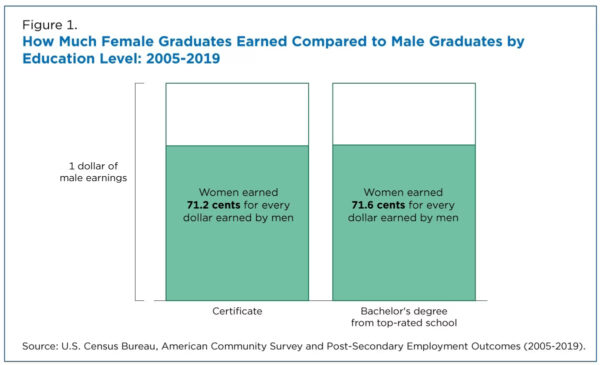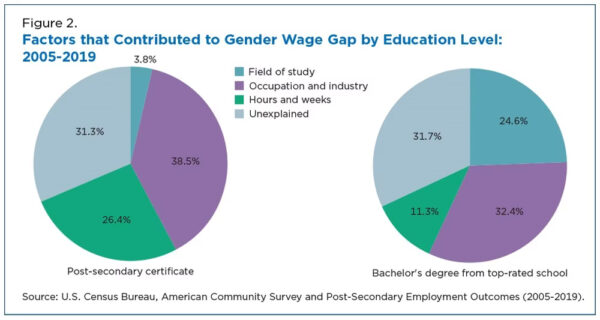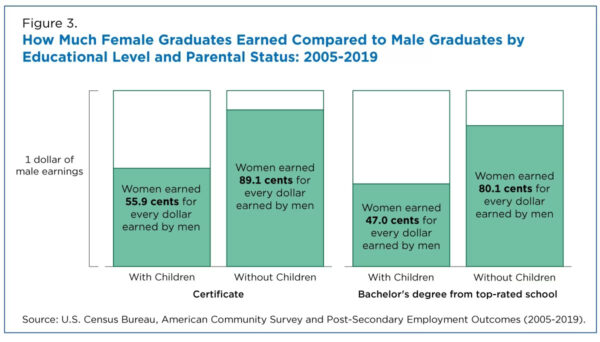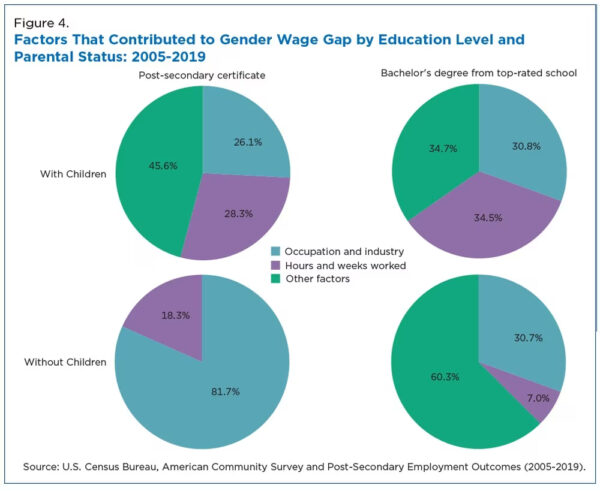Is the Gender Wage Gap the Same at Different Education Levels?
February 23, 2024

By Kendall Houghton, Ariel J. Binder, Amanda Eng and Andrew Foote
The gender wage gap — the difference between what men and women earn — is an often-cited marker of the progress women are making in the work force typically measured by comparing the average earnings of men and women.
Previous U.S. Census Bureau research has explored the gender wage gap and how it varies with social, economic and demographic characteristics.
Now, new U.S. Census Bureau research takes it a step further by comparing male and female earnings for graduates of similar educational programs. Rather than comparing male and female wages and controlling for education, it looks at the earnings of men and women with the same level and quality of education.
This research provides new information about the gender pay gap across a range of postsecondary education levels from graduates of the most selective bachelor programs to graduates of certificate programs.
After accounting for differences in choice of major, the share of the gap due to occupation and industry chosen was nearly the same regardless of education level.
The Census Bureau analyzed the earnings of graduates from certificate, associate and bachelor’s programs for up to 15 years. It estimated the magnitude of the earnings gap at these educational levels and three factors that may contribute to it: field of study; occupation and industry after graduation; and number of weeks and hours worked in a year.
This research was made possible by a partnership between the Census Bureau and state higher education systems, which provided student transcript records that can be linked to other datasets.
In this case, the student records were linked to the American Community Survey (ACS) to gauge post-graduation outcomes such as earnings, occupation, childbearing, and the number of weeks and hours worked. The ACS is the premier source of detailed population and housing information about our nation.
Researchers analyzed the gender pay gap using a statistical model that answered the following questions for each degree level considered:
- How large was the gap between men’s and women’s earnings, on average?
- How much of this gap was driven by women and men majoring in different fields?
- Among women and men with the same education level who graduated in the same field, how much of the gap stemmed from women and men working in different occupations and industries?
- Among men and women with the same education level, who graduated in the same field and worked in the same occupation, how much of the gap was caused by women and men participating in the workforce at different rates and working different numbers of weeks and hours-per-week during the year?
- How much of the gender pay gap was due to other factors?
Answers differed considerably depending on whether someone graduated from a certificate or selective bachelor’s program.
The Size of the Gender Earnings Gap
The gap in average earnings from 2005 to 2019 was consistent across all education levels. As shown in Figure 1, women with a certificate degree earned 71.2 cents for every dollar earned by men with a certificate degree. In other words, the gap was 28.8%. For graduates of the most selective bachelor’s institutions, as defined by the Barron’s Admissions Competitiveness Index, the gap was 28.4%.
This gap is larger than the 84 cents for every dollar earned figure reported by the White House, which compares full-time, year-round working men and women. The comparisons in this report are between graduates.

Field of Study
College major or field of study accounted for a substantial portion of the gap at higher education levels but were less significant at lower levels.
For example, 3.8% of the gender gap in earnings among those with certificate degrees was attributed to choice of major/field of study, compared to 24.6% among graduates of the most selective bachelor’s programs (Figure 2).

Occupation and Industry Factors
After accounting for differences in choice of major, the share of the gap due to occupation and industry chosen was nearly the same regardless of education level.
Occupational choices accounted for 38.5% of the gap among certificate degree graduates and 32.4% of the gap among graduates of selective bachelor’s programs (Figure 2).
Differences in labor supply — which reflect a combination of gender differences in employment rates as well as gender differences in the number of weeks and hours-per-week worked in a year of those employed — had a greater impact on the pay gap among graduates of certificate and associate programs than among those with bachelor’s degrees.
Labor supply accounted for 26.4% of the pay gap among certificate holders but only 11.3% among graduates of the most selective bachelor’s programs (Figure 2).
In Figures 2 and 4, the “unexplained” is the share of the gap that is not explained by differences in field of study, occupation and industry, or hours and weeks worked.
The Children Factor
Previous research has shown that having children contributed significantly to the gender pay gap.
And as Figure 3 shows, this study found the wage gap was considerably wider among men and women with than without children — more than double for top bachelor’s holders and quadruple for certificate graduates.

Figure 4 illustrates this jump was mostly fueled by labor supply among graduates of certificate programs and by occupation and labor supply choices among grads of highly selective bachelor’s programs.

Gender Pay Gap Varied Across the Educational Attainment Distribution
Until recently, data limitations prevented researchers from investigating variations in the gender pay gap across different types of degrees and paths taken by graduates.
Thanks to our partnership with higher education systems, we can now get to the bottom of whether and how the gender pay gap relates to types of degrees earned.
The results paint a more complex portrait of the gender pay gap, found to exist at every level. College graduates and policymakers can use this more detailed information to better understand and dismantle contemporary barriers to gender equality.
About Authors
- Ariel Binder, Amanda Eng and Kendall Houghton are economists in the Center for Economic Studies Demographic Research Area.
- Andrew Foote is a principal economist in the Center for Economic Studies LEHD Research Area.































